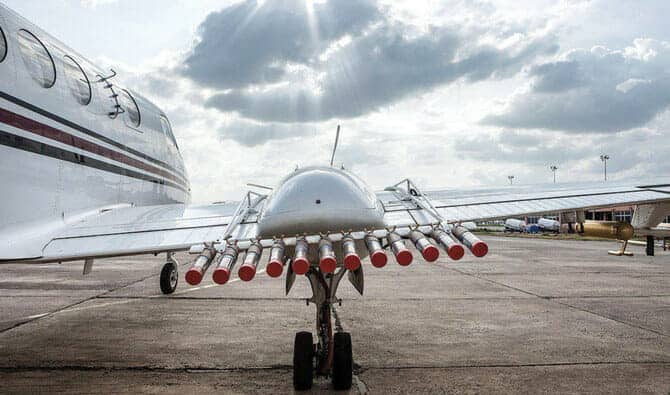For arid countries such as the UAE, Saudi Arabia and others in the region, rainfall is scanty and the GCC governments have devised ways to ensure adequate potable water by constructing desalination plants on a large scale.
While these plants are expensive as they consume huge quantum of electricity releasing carbon emissions into the atmosphere, the governments have taken up cloud seeding projects to meet the water demand from their growing populations.
The cloud seeding experiments are considered economically viable but it also has its side effects.
The UAE is among the first countries in the Middle East to use cloud seeding technology for a project whose trials started in late 1990s.
However, the US$11m worth project took a shape in July 2010 and proved to be a success in creating rain storms in the country. Scientists have estimated that cloud seeding operations can enhance rainfall by as much as 30-35 percent in a clear atmosphere, and by up to 10-15 percent in a turbid atmosphere.
In 2014, a total of 187 missions were conducted for seed clouding followed by 242 in 2017, 184 in 2018 and 247 in 2019.
However, the government used a new technology this year by equipping drones with a payload of electric-charge emission instruments and customised sensors which flew at low altitudes to deliver an electric charge to air molecules.
This new technology resulted in significant rainstorm in July 2021 with Al Ain receiving 6.9 millimetres on July 20 and 21. These operations were carried out mainly over the eastern mountains on the border to Oman to raise levels in aquifers and reservoirs.
While Saudi Arabia’s cabinet has approved the proposal to start cloud seeding, Qatar too tried to follow suit but the government did not undertake the project on the line that it was not feasible.
Regional weather patterns mean that Qatar would most likely only benefit from a neighbouring country’s cloud seeding operations, especially if they took in Saudi Arabia.
Cost effective
Coming to the cost factor, cloud seeding in the UAE costs far less than desalination of as much as 1000 litres of water. Cloud seeding costs around US$1.09 while the desalination of the same amount costs almost US$59.88 for 1000 litres of water.
The UAE’s National Centre for Atmospheric Research (NCAR) estimates that a medium-sized cumulus cloud can contain approximately 275 million gallons of water.
“Assuming a 5 percent increase in rainfall, the resulting produced water is around 13.75 million gallons. This equates to approximately 55,000 cubic metres. Assuming a price of US$0.60 per cubic metre, the total cost would be US$33,543,” the NCAR said adding that a 20 percent increase in rainfall will generate 55 million gallons of water costing around US$134,175.
According to International Desalination Association (IDA), a large-scale desalination plant producing about 100,000 cubic metres of water per day costs US$100m, equating to US$1m for every 1000 cubic metres.
The UAE has only desalination plants and rain water as sources of drinking water and has no other option except cloud seeding for fresh water.
Side effects
Those who support cloud seeding claim that the impact of such experiments has little or no impact on the environment as it uses natural minerals rather than man-made chemicals.
However, it was widely reported that 34 people died in a UK village Lynemouth when it was hit by a freak storm, apparently caused by a government supported cloud seeding programme between August 4 and 15 in 1953.
Any country should have proper drainage system to drain out storm water caused by cloud seeding and also to store the water at vantage points. Otherwise, the entire exercise will be futile and the money is lost.
In March 2017, the Dubai Police reported as many as 1,447 road accidents, most of them minor in nature, over three days due to waterlogging of areas caused by flooding in parts of the city.
A dried ground needs time to absorb moisture readily and as a result, the rain water turns into flash floods in deserts causing loss to human lives and properties.
Such floods can even damage crops like excess snowfall affecting the routine activities. By trying to solve one problem, the planners should not create another.








